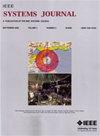Joint Optimization of UAV Trajectory and Number of Reflecting Elements for UAV-Carried IRS-Assisted Data Collection in WSNs Under Hover Priority Scheme
IF 4.4
3区 计算机科学
Q1 COMPUTER SCIENCE, INFORMATION SYSTEMS
引用次数: 0
Abstract
Uncrewedaerial vehicle (UAV)-carried intelligent reflecting surfaces (U-IRSs) can be utilized to assist blocked communications between sensor nodes (SNs) and the fusion center in wireless sensor networks (WSNs). This article investigates a U-IRS-assisted data collection system in WSNs that employs the hover priority scheme. Given the energy constraints of UAV, the combined energy consumption from UAV moving/hovering and IRS reflecting elements configuration circuitry poses significant challenges to improving the system’s energy efficiency (EE). To address this challenge, we formulate a multiobjective optimization problem under the constraints of UAV and SN power budgets to make a tradeoff between EE and spectral efficiency. Due to the nonconvexity of the formulated problem, we divide the main problem into three subproblems: user association, the number of reflecting elements, and UAV trajectory optimization. An alternating optimization algorithm integrating the genetic algorithm, the CJ-BS-based cyclic iteration algorithm, Dinkelbach’s algorithm, and the successive convex approximation method is proposed to solve these subproblems. Simulation results demonstrate that the proposed solution outperforms the UAV hovering directly above each SN scheme.悬停优先方案下机载红外辅助采集无线传感器网络无人机轨迹与反射元数联合优化
无人机(UAV)携带的智能反射面(U-IRSs)可以用来辅助无线传感器网络(WSNs)中传感器节点(SNs)和融合中心之间的阻塞通信。本文研究了一种采用悬停优先级方案的无线传感器网络u - irs辅助数据采集系统。考虑到无人机的能量限制,无人机移动/悬停和IRS反射元件配置电路的综合能耗对提高系统能效(EE)提出了重大挑战。为了解决这一挑战,我们在无人机和无线网络的功率预算约束下制定了一个多目标优化问题,以在EE和频谱效率之间进行权衡。由于所提问题的非凸性,我们将主问题分为三个子问题:用户关联问题、反射元素数量问题和无人机轨迹优化问题。提出了一种结合遗传算法、基于cj - bs的循环迭代算法、Dinkelbach算法和逐次凸逼近法的交替优化算法来求解这些子问题。仿真结果表明,该方案优于无人机悬停方案。
本文章由计算机程序翻译,如有差异,请以英文原文为准。
求助全文
约1分钟内获得全文
求助全文
来源期刊

IEEE Systems Journal
工程技术-电信学
CiteScore
9.80
自引率
6.80%
发文量
572
审稿时长
4.9 months
期刊介绍:
This publication provides a systems-level, focused forum for application-oriented manuscripts that address complex systems and system-of-systems of national and global significance. It intends to encourage and facilitate cooperation and interaction among IEEE Societies with systems-level and systems engineering interest, and to attract non-IEEE contributors and readers from around the globe. Our IEEE Systems Council job is to address issues in new ways that are not solvable in the domains of the existing IEEE or other societies or global organizations. These problems do not fit within traditional hierarchical boundaries. For example, disaster response such as that triggered by Hurricane Katrina, tsunamis, or current volcanic eruptions is not solvable by pure engineering solutions. We need to think about changing and enlarging the paradigm to include systems issues.
 求助内容:
求助内容: 应助结果提醒方式:
应助结果提醒方式:


